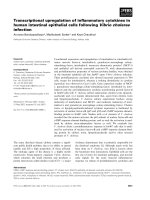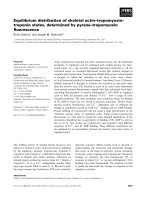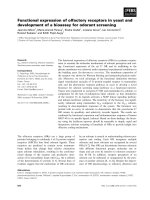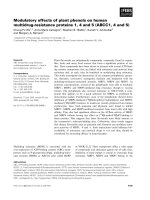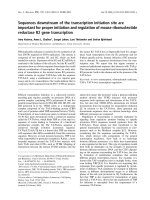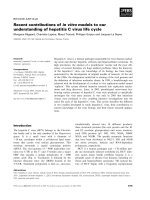Báo cáo khoa học: "Post-thaw development of in vitro produced buffalo embryos cryopreserved by cytoskeletal stabilization and vitrification" pps
Bạn đang xem bản rút gọn của tài liệu. Xem và tải ngay bản đầy đủ của tài liệu tại đây (235.04 KB, 4 trang )
JOURNAL OF
Veterinary
Science
J. Vet. Sci. (2009), 10(2), 153
156
DOI: 10.4142/jvs.2009.10.2.153
*Corresponding author
Tel: +91-9880341424; Fax: +91-80-22293771
E-mail:
Post-thaw development of in vitro produced buffalo embryos
cryopreserved by cytoskeletal stabilization and vitrification
B. M. Manjunatha
1,
*
, J. P. Ravindra
2
, P. S. P. Gupta
2
, M. Devaraj
1
, T. G. Honnappa
1
, A. Krishnaswamy
1
1
Department of Animal Reproduction, Gynaecology and Obstetrics, Veterinary College, Karnataka Veterinary, Animal and
Fishery Sciences University, Bangalore-560 024, India
2
National Institute of Animal Nutrition and Physiology, Indian Council of Agricultural Research, Adugodi, Bangalore-560
030, India
The present study was conducted to examine post-thaw in
vitro developmental competence of buffalo embryos
cryopreserved by cytoskeletal stabilization and vitrification.
In vitro produced embryos were incubated with a medium
containing cytochalasin-b (cyto-b) in a CO
2
incubator for 40
min for microfilament stabilization and were cryopreserved
by a two-step vitrification method at 24
o
C in the presence of
cyto-b. Initially, the embryos were exposed to 10% ethylene
glycol (EG) and 10% dimethylsulfoxide (DMSO) in a base
medium for 4 min. After the initial exposure, the embryos
were transferred to a 7
μ
l drop of 25% EG and 25% DMSO
in base medium and 0.3 M sucrose for 45 sec. After warming,
the embryos were cultured in vitro for 72 h. The post-thaw in
vitro developmental competence of the cyto-b-treated embryos
did not differ significantly from those vitrified without cyto-b
treatment. The hatching rates of morulae vitrified without
cyto-b treatment was significantly lower than the non-
vitrified control. However, the hatching rate of cyto-b-
treated vitrified morulae did not differ significantly from the
non-vitrified control. This study demonstrates that freezing
of buffalo embryos by cytoskeletal stabilization and
vitrification is a reliable method for long-term preservation.
Keywords:
buffalo, cytochalasin-b, embryo, vitrificationm
Introduction
The major obstacle to the large-scale commercial application
of in vitro produced (IVP) embryos, particularly in buffalos,
is the lack of a suitable cryopreservation method. Approaches
like slow freezing, fast cooling, slow or fast warming and
vitrification have been employed to cryopreserve the
embryos of domestic animals. Vitrification is a physical
process in which a solution is transformed into a stable
amorphous glass by rapid cooling, bypassing ice crystal
formation while maintaining the properties of the liquid in
a solidified form [16]. The glass is devoid of ice crystals
and embryos are not subjected to cellular damage associated
with ice crystal formation [17]. The in vitro and in vivo
survival rates of vitrified embryos are reasonable in cattle
[2,9,15] and buffaloes [8,10,11].
Cryopreservation can be extremely disruptive to the
cellular organization of embryos [5]. To minimize cytoskeletal
disruption of the embryos during and after cryopreservation,
cytoskeletal stabilizers are added to the vitrification solution.
Information on cryopreservation of IVP buffalo embryos
by vitrification is scarce. The present study was carried out
to examine the post-thaw in vitro developmental competence
of buffalo embryos cryopreserved by cytoskeletal stabilization
and vitrification.
Materials and Methods
Media and chemicals were obtained from Sigma-Aldrich
(USA) unless otherwise indicated. Filters having a 0.22
μm pore size were from Millipore (USA). Large, square
and circular 35 mm-diameter disposable Falcon plastic
dishes, and plastic tubes were purchased from Becton
Dickinson Labware (USA). Steer serum (SS) was collected
from the institute herd by clotting the blood from a long-
term castrated bullock, which was then heat inactivated at
56
o
C for 30 min, sterilized by filtration and stored in 2 ml
aliquots at 20
o
C until use. The same pool of serum was
used throughout the study.
In vitro embryo production
Ovaries were collected from mature, non-pregnant buffaloes
(Bubalus bubalis) from the Corporation slaughterhouse,
Bangalore, and brought to the laboratory in normal saline (32
∼33
o
C) supplemented with gentamicin (50 μg/ml) within
2 h after slaughter. Ovaries were washed three times in
154 B. M. Manjunatha et al.
Vitrification medium composition
Morulae Blastocysts
n Expansion (%) Hatching (%) n Expansion (%) Hatching (%)
25% EG + 25% DMSO (vitrified control)
25% EG + 25% DMSO + cyto-b
N
on-vitrified control
65
69
58
45.4 ± 6.5
a
53.8 ± 5.4
ab
74.5 ± 6.6
b
19.3 ± 3.3
a
30.4 ± 2.6
ab
46.5 ± 8.0
b
72
76
60
66.4 ± 6.7
a
75.2 ± 4.0
a
78.1 ± 2.7
a
41.3 ± 5.7
a
55.3 ± 3.7
a
54.8 ± 3.4
a
Means within the same column with different superscript differ significantly (p < 0.05). EG: ethylene glycol, G: glycerol, DMSO:
dimethylsulfoxide, cyto-b: cytochalasin-b.
Tabl e 1 . Post-thaw in vitro development of buffalo embryos after cryopreservation by vitrification under the influence of microfilamen
t
stabilizer cyto-b
normal saline in the laboratory and extra-ovarian tissues
were removed. The oocytes were aspirated from the visible
surface antral follicles using a 20 gauge hypodermic needle
attached to a 5 ml syringe containing 0.5∼1.0 ml of aspiration
medium consisting of TCM 199 supplemented with 5% SS.
Oocytes were identified and their morphology evaluated
using a stereo zoom microscope; oocytes having a compact
cumulus investment were retained for use. The oocytes
were washed once with an aspiration medium and twice in
a culture medium consisting of TCM 199, 10% SS, 50 μM
of cysteamine and 0.02 U of porcine follicle stimulating
hormone/ml. Oocytes in groups of 5∼10 were transferred
to 50 μl droplets of culture medium. The oocyte-containing
droplets were covered with warm (38.5
o
C) mineral oil and
in vitro maturation of the oocytes proceeded during
incubation at 38.5
o
C and 90∼95% relative humidity in an
atmosphere of 5% CO
2
for 24 h. The in vitro fertilization
(day 0) of oocytes and culture of embryos was performed
as previously described [11]. Good quality compact
morulae on day 6 and blastocysts on day 7 were selected for
vitrification.
Microfilament stabilization and vitrification
Embryos were incubated in a CO
2
incubator for 45 min in
an embryo culture medium consisting of TCM 199 and 10%
SS supplemented with 7.5 μg/ml cytochalasin-b (cyto-b)
for microfilament stabilization. These embryos were
vitrified following a two-step addition of cryoprotectant in
the presence of cyto-b. Initially, the embryos were exposed
to 10% ethylene glycol (EG) and 10% dimethylsulfoxide
(DMSO) in base medium for 4 min. After the initial
exposure, the embryos were transferred to a 7 μl drop of
25% EG and 25% DMSO in base medium and 0.3 M
sucrose for 45 sec. During the second exposure step, the
embryos were loaded into the middle part of 0.25 ml straws
(IMV; 3∼4 embryos per straw) in a small volume of
vitrification solution. The rest of the straw was filled with
a dilution medium consisting of 0.5 M sucrose in base
medium that was separated by air bubbles from the column
of vitrification solution containing the embryos. The straw
was then heat-sealed and, 45 sec later, was plunged
vertically, sealed end first, into liquid nitrogen to cover the
embryos. The rest of the straw was then slowly immersed
into the liquid nitrogen within 30 sec. In the vitrified control
group, the embryos were vitrified without the inclusion of
microfilament stabilization and cyto-b in the vitrification
medium. After 1 week of cryopreservation, the straws were
warmed in air (24
o
C) for 10 sec and then in water bath
horizontally at 20
o
C until the ice disappeared. The straw
was held at the sealed end and shaken to mix the columns.
The embryos were expelled into a 30-mm diameter Petri
dish and maintained at 24
o
C for 5 min. To remove cyto-b,
the embryos were washed three times in 200 μl drops of
embryo culture medium. The embryos were cultured for
further development in the embryo culture medium on a
7-day-old monolayer of oviductal epithelial cells in a CO
2
incubator. Re-expansion and hatching rates for morulae
and blastocysts were evaluated at 72 h post-thaw in vitro
culture. For the non-vitrified control, non-vitrified morulae
and blastocysts from the same batch as vitrified samples
were cultured on a monolayer of oviductal epithelial cells
in a CO
2
incubator for 72 h after being held at 24
o
C during
the entire vitrification procedure.
Statistical analyses
The percentage values were subjected to arcsine
transformation before being statistically analyzed. The data
on post-thaw in vitro development of morulae and blastocysts
were analyzed by one way ANOVA to verify differences
between the groups followed by the Bonneforni multiple
comparison test between group means by using statistical
software (GraphPad Prism; GraphPad, USA). Significance
of differences between the mean values was determined at
p < 0.05. Results are expressed as mean ± SE.
Results
The expansion and hatching rate of cyto-b-treated vitrified
morulae did not differ significantly from non-vitrified
controls on post-thaw in vitro culture (Table 1). However,
Post-thaw development of in vitro produced buffalo embryos 155
the expansion and hatching rate of morulae vitrified without
cyto-b treatment was significantly lower than the non-
vitrified control. The development of blastocysts vitrified
with or without cyto-b treatment to expansion and hatching
stages did not differ significantly from non-vitrified control.
However, hatching rates of cyto-b-treated morulae and
blastocysts were not significantly higher than those vitrified
without cyto-b treatment.
Discussion
The present study examined the post-thaw in vitro
developmental competence of buffalo embryos cryopreserved
by cytoskeletal stabilization and vitrification. Post-thaw in
vitro developmental competence of the embryos vitrified
after cytoskeletal stabilization in the presence of cyto-b did
not differ significantly than those vitrified without
microfilament stabilization and cyto-b in the vitrification
medium. Embryo survival depends on the cryoprotectant
used, species involved, and stage of development, as well as
the culture systems used for IVP embryos. Cryoprotectant
mixtures like EG and DMSO may have some advantages
over solutions containing only one penetrating cryoprotectant
[3,14,20]. The ability of embryos to hatch after 48 h post-
thaw in vitro culture is improved when two (EG, DMSO)
or three (EG, DMSO and 1,3-butanediol) permeating
cryoprotectants are included in the vitrification media
rather than a single permeating cryoprotectant like EG
[15]. The use of two permeable cryoprotectants rather than
a single cryoprotectant such as EG enables the use of lower
concentrations of each cryoprotectant, thereby reducing
cryoprotectant toxicity. The composition of a vitrification
solution (permeating cryoprotectants and non-permeating
macromolecules or saccharides) is among the factors
influencing cryosurvival of embryos. The incorporation of
DMSO into an EG-containing medium has at least two
advantages. Firstly, vitrification is facilitated because of
the greater glass-forming characteristics of DMSO [1].
Secondly, permeability of each cryoprotectant is enhanced
in the presence of the other [21]. In buffaloes, the morulae
and blastocyts vitrified by a 4 min exposure to 25% EG and
25% DMSO display a better hatching rate than other
combinations of vitrification medium composition and
exposure time [10].
Cytoskeletal stabilizers such as the cytochalasins have been
used extensively in reproductive biotechnology for studies
dealing with micromanipulation of embryonic development
[12,18]. It is generally accepted that cytochalasin is a
microfilament inhibitor capable of disrupting actin
polymerization by blocking monomer addition at the fast-
growing end of the polymers [19], thus preventing cytokinesis
without affecting karyokinesis [4,13]. Treatment of cells
with cytochalasins makes the plasma membrane less rigid
and more elastic so that microfilaments are disrupted during
micromanipulation [12]. In the present study, the post thaw
in vitro developmental competence of cyto-b-treated embryos
was not affected.
Cryoprotectants-the organic solutes that help to protect
cellular organelles during cryopreservation-can also damage
the cytoskeletal system, as they can be toxic and cause
disruptive osmotic damage to the cell. Although many
cryoprotectants depolymerize microfilaments and
microtubules prior to cryopreservation, they might cause
irreparable damage to cytoskeletal components. An intact
cytoskeleton is essential for cytokinesis and karyokinesis;
irreversibly disruption of the cytoskeleton will abrogate the
mitotic cell cycle, could compromise junctional complexes
and affects solute transport systems. Maintaining the
integrity of the cytoarchitecture within an embryo during
cryopreservation is, thus, of utmost importance. In porcines,
cyto-b-treated embryos display better development than
those vitrified without cyto-b treatment [6]. Similarly, in
the present study the hatching rates of cyto-b-treated
morulae and blastocysts were not significantly higher than
those vitrified without cyto-b treatment.
In conclusion, the present study demonstrates that
cryopreservation of buffalo embryos by cytoskeletal
stabilization and vitrification is a reliable method for long-
term preservation. IVP buffalo embryos cryopreserved by
cytoskeletal-stabilization and vitrification achieved a
maximum hatching rate of 30% and 55% on post-thaw in
vitro culture of morulae and blastocysts.
Acknowledgments
We thank Dr. K. T. Sampath, Director, National Institute
of Animal Nutrition and Physiology, Bangalore, India for
providing the necessary facilities to complete this research.
References
1. Ali J, Shelton JN. Design of vitrification solutions for the
cryopreservation of embryos. J Reprod Fertil 1993, 99,
471-477.
2. Campos-Chill
òn LF, Walker DJ, de la Torre-Sanchez
JF, Seidel GE Jr. In vitro assessment of a direct transfer
vitrification procedure for bovine embryos. Theriogenology
2006, 65, 1200-1214.
3. Critser JK, Agca Y, Gunasena KT. The cryobiology of
mammalian oocytes. In: Karow AM, Critser JK (eds.).
Reproductive Tissue Banking: Scientific Principles. pp.
332-358, Academic Press, San Diego, 1997.
4. Cuthbertson KSR. Parthenogenetic activation of mouse
oocytes in vitro with ethanol and benzyl alcohol. J Exp Zool
1983, 226, 311-314.
5. Dobrinsky JR. Cellular approach to cryopreservation of
embryos. Theriogenology 1996, 45, 17-26.
6. Dobrinsky JR, Pursel VG, Long CR, Johnson LA. Birth
of piglets after transfer of embryos cryopreserved by
156 B. M. Manjunatha et al.
cytoskeletal stabilization and vitrification. Biol Reprod
2000, 62, 564-570.
7. Gasparrini B. In vitro embryo production in buffalo
species: state of the art. Theriogenology 2002, 57, 237-256.
8. Hufana-Duran D, Pedro PB, Venturina HV, Hufana RD,
Salazar AL, Duran PG, Cruz LC. Post-warming hatching
and birth of live calves following transfer of in vitro-derived
vitrified water buffalo (Bubalus bubalis) embryos.
Theriogenology 2004, 61, 1429-1439.
9. Kaidi S, Donnay I, Van Langendonckt A, Dessy F,
Massip A. Comparison of two co-culture systems to assess
the survival of in vitro produced bovine blastocysts after
vitrification. Anim Reprod Sci 1998, 52, 39-50.
10. Manjunatha BM, Gupta PS, Ravindra JP, Devaraj M,
Nandi S. Effect of vitrification medium composition and
exposure time on post-thaw development of buffalo embryos
produced in vitro. Vet J 2009, 179, 287-291.
11. Manjunatha BM, Gupta PSP, Ravindra JP, Devaraj M,
Nandi S. In vitro embryo development and blastocyst
hatching rates following vitrification of river buffalo embryos
produced from oocytes recovered from slaughterhouse
ovaries or live animals by ovum pick-up. Anim Reprod Sci
2008, 104, 419-426.
12. McGrath J, Solter D. Nuclear transplantation in the mouse
embryo by microsurgery and cell fusion. Science 1983, 220,
1300-1302.
13. Modli
ński JA. Preimplantation development of microsurgically
obtained haploid and homozygous diploid mouse embryos
and effects of pretreatment with Cytochalasin B on enucleated
eggs. J Embryol Exp Morphol 1980, 60, 153-161.
14. Paynter SJ, Cooper A, Fuller BJ, Shaw RW. Cryopreservation
of bovine ovarian tissue: structural normality of follicles after
thawing and culture in vitro. Cryobiology 1999, 38, 301-309.
15. Pugh PA, Tervit HR, Niemann H. Effects of vitrification
medium composition on the survival of bovine in vitro
produced embryos, following in straw-dilution, in vitro and
in vivo following transfer. Anim Reprod Sci 2000, 58, 9-22.
16. Rall WF. Factors affecting the survival of mouse embryos
cryopreserved by vitrification. Cryobiology 1987, 24, 387-402.
17. Rall WF, Fahy GM. Ice-free cryopreservation of mouse
embryos at -196°C by vitrification. Nature 1985, 313, 573-575.
18. Surani MAH, Barton SC, Norris ML. Development of
reconstituted mouse eggs suggests imprinting of the genome
during gametogenesis. Nature 1984, 308, 548-550.
19. Theodoropoulos PA, Gravanis A, Tsapara A, Margioris
AN, Papadogiorgaki E, Galanopoulos V, Stournaras C.
Cytochalasin B may shorten actin filaments by a mechanism
independent of barbed end capping. Biochem Pharmacol
1994, 47, 1875-1881.
20. Vajta G, Rindom N, Peura TT, Holm P, Greve T, Callesen
H. The effect of media, serum and temperature on in vitro
survival of bovine blastocysts after open pulled straw (OPS)
vitrification. Theriogenology 1999, 52, 939-948.
21. Vicente JS, Garc
ía-Ximénez F. Osmotic and cryoprotective
effects of a mixture of DMSO and ethylene glycol on rabbit
morulae. Theriogenology 1994, 42, 1205-1215.

